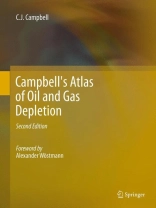Campbell’s Atlas of Oil and Gas Depletion, Second Edition, is the product of a half-century of critical analysis and updating of data on the status of oil and gas depletion by country, region and the world as a whole. Separate analyses of conventional and non-conventional oil and gas, which are depleting at different rates and costs, show when these critical energy sources peak and decline. The Atlas also summarizes the history and political circumstances of each country to assess the impact on oil and gas production and reserves. It contrasts the First Half of the Oil Age, which saw the rapid expansion of the world economy, allowing the population to grow six-fold, with the Second Half, which will witness a general contraction as these easy, high-density energy supplies dwindle. The transition threatens to be a time of great economic, financial and political tensions. The Atlas, which has been compiled and updated by prominent geologist, former oil company executive, and oil analyst Colin Campbell since the 1960s, addresses the need for a reliable and comprehensive database on a subject essential to governments, industry, academia, and the population as a whole as we attempt to adapt to these critically changing circumstances.
Table of Content
Preface
Foreword
Units and Conversion Factors
Part I: Introduction, Reporting, and Methodology
Chapter 1- INTRODUCTION
Chapter 2 – THE ESTIMATION AND REPORTING OF RESERVES AND PRODUCTION
Chapter 3 – THE METHODOLOGY OF THE DEPLETION MODEL
Part II: AFRICA
Chapter 4: Algeria
Chapter 5: Angola
Chapter 6: Cameroon
Chapter 7: Chad
Chapter 8: Congo
Chapter 9: Egypt
Chapter 10: Gabon
Chapter 11: Libya
Chapter 12: Nigeria
Chapter 13: Sudan
Chapter 14: Tunisia
Chapter 15: Uganda
Chapter 16: Africa Region
Part III: ASIA-PACIFIC
Chapter 17: Australia
Chapter 18: Brunei
Chapter 19: India
Chapter 20: Indonesia
Chapter 21: Malaysia
Chapter 22: Pakistan
Chapter 23: Papua – New Guinea
Chapter 24: Thailand
Chapter 25: Vietnam
Chapter 26: Asia-Pacific Region
Part IV: EURASIA
Chapter 27: Albania
Chapter 28: Azerbaijan Chapter 29: China
Chapter 30: Croatia
Chapter 31: Hungary
Chapter 32: Kazakhstan
Chapter 33: Romania
Chapter 34: Russia
Chapter 35: Turkmenistan
Chapter 36: Ukraine
Chapter 37: Uzbekistan
Chapter 38: Eurasia Region
Part V: EUROPE
Chapter 39: Austria
Chapter 40: Denmark
Chapter 41: France
Chapter 42: Germany
Chapter 43: Italy
Chapter 44: Netherlands
Chapter 45: Norway
Chapter 46: United Kingdom
Chapter 47: Europe Region
Part VI: LATIN AMERICA
Chapter 48: Argentina
Chapter 49: Bolivia
Chapter 50: Brasil
Chapter 51: Chile
Chapter 52: Colombia
Chapter 53: Ecuador
Chapter 54: Mexico
Chapter 55: Peru
Chapter 56: Trinidad
Chapter 57: Venezuela
Chapter 58: Latin America Region
Part VII: MIDDLE EAST
Chapter 59: Bahrain
Chapter 60: Iran
Chapter 61: Iraq
Chapter 62: Kuwait
Chapter 63: Neutral Zone
Chapter 64: Oman
Chapter 65: Qatar
Chapter 66: Saudi Arabia
Chapter 67: Syria
Chapter 68: Turkey
Chapter 69: United Aran Emirates
Chapter 70: Yemen
Chapter 71: Middle East Region
Part VIII: NORTH AMERICA
Chapter 72: Canada
Chapter 73: United States
Chapter 74: REGION
Part IX: Global Analysis and Perspective
Chapter 75: THE WORLD’S REGULAR CONVENTIONAL OIL AND GAS
Chapter 76: THE WORLD’S NON-CONVENTIONAL OIL AND GAS
Chapter 77: THE OIL AGE IN PERSPECTIVE
BIBLIOGRAPHY












